A Petri Net Model for Cognitive Radio Internet of Things Networks Exploiting GSM Bands †
Abstract
1. Introduction
- Long radio range: the device usually leverages a licensed band of cellular networks, and as such, it could be expensive; LoRa (short for long range) and satellite are also used technologies;
- Medium radio range (no greater than 100 m): the most common radio technologies include ZigBee, Wi-Fi, Z-Wave, and thread;
- Short radio range (not exceeding 30 m): the most common radio technologies in use; it includes Bluetooth (or its evolution, Bluetooth LE) and RFID.
2. Related Works
- We consider a synchronized access to the channel in order to reduce the probability of collision with PUs;
- We propose a novel model of the GSM/EDGE PU traffic based on a Petri net, which takes into account the transponder load condition (so that it can be tuned in terms of expected load) in terms of the usage of the slotted periodical TDMA by both typical switching circuit and packet switching circuits;
- We also capture specific characteristics of mobile phone calls, such as the discontinuous transmissions obtained in the PU, thanks to the use of a voice activity detector;
- Taking into account a more realistic traffic model, we evaluate the service time and jitter of SUs, and we can validate the results while considering a more accurate distribution of the busy period.
3. Characterization of the Cognitive Environment
3.1. Characterization of the GSM Primary User
- GSM;
- CSD;
- GPRS;
- Enhanced CSD (ECSD);
- Enhanced GPRS (EGPRS).
3.2. Characterization of the Secondary User
4. QoS Evaluation of Secondary User Based on NMSPNs
- is the set of places;
- is the set of transitions;
- are, respectively, the input, output, and inhibitor arcs’ functions; they map the transitions to bags of places (a bag is a set in which the replication of elements is allowed, and it keeps track of the “multiplicity” of each element);
- is a function that maps each immediate transition into a constant weight ;
- is a function that maps each timed transition into a cumulative distribution function (CDF) ;
- is a function that maps each timed transition into a preemption memory policy
- is a function that associates a priority to each transition ;
- is the initial marking, i.e., the initial distribution of tokens among the places in , which represents the initial state of the model.
4.1. The Primary User Model
4.2. The Secondary User Model
SU Performance Measures
5. Numerical Results
6. Conclusions
Author Contributions
Funding
Data Availability Statement
Conflicts of Interest
References
- Grasso, C.; Raftopoulos, R.; Schembra, G.; Serrano, S. H-HOME: A learning framework of federated FANETs to provide edge computing to future delay-constrained IoT systems. Comput. Netw. 2022, 219, 109449. [Google Scholar] [CrossRef]
- Grasso, C.; Raftopoulos, R.; Schembra, G. Smart Zero-Touch Management of UAV-based Edge Network. IEEE Trans. Netw. Serv. Manag. 2022, 19, 4350–4368. [Google Scholar] [CrossRef]
- Li, X.; Fang, J.; Cheng, W.; Duan, H.; Chen, Z.; Li, H. Intelligent power control for spectrum sharing in cognitive radios: A deep reinforcement learning approach. IEEE Access 2018, 6, 25463–25473. [Google Scholar] [CrossRef]
- Giannopoulos, A.; Spantideas, S.; Kapsalis, N.; Karkazis, P.; Trakadas, P. Deep reinforcement learning for energy-efficient multi-channel transmissions in 5G cognitive hetnets: Centralized, decentralized and transfer learning based solutions. IEEE Access 2021, 9, 129358–129374. [Google Scholar] [CrossRef]
- Tarek, D.; Benslimane, A.; Darwish, M.; Kotb, A.M. Survey on spectrum sharing/allocation for cognitive radio networks Internet of Things. Egypt. Inform. J. 2020, 21, 231–239. [Google Scholar] [CrossRef]
- Akyildiz, I.F.; Lee, W.Y.; Vuran, M.C.; Mohanty, S. NeXt generation/dynamic spectrum access/cognitive radio wireless networks: A survey. Comput. Netw. 2006, 50, 2127–2159. [Google Scholar] [CrossRef]
- Gao, J.; Suraweera, H.A.; Shafi, M.; Faulkner, M. Channel capacity of a cognitive radio network in GSM uplink band. In Proceedings of the IEEE International Symposium on Communications and Information Technologies, ISCIT’07, Sydney, Australia, 17–19 October 2007; pp. 1511–1515. [Google Scholar]
- McHenry, M.; McCloskey, D.; Lane-Roberts, G. Spectrum Occupancy Measurements Location 4 of 6: Republican National Convention, New York City, New York; Technical Report; Shared Spectrum Company: Vienna, VA, USA, 2005. [Google Scholar]
- Haykin, S. Cognitive radio: Brain-empowered wireless communications. IEEE J. Sel. Areas Commun. 2005, 23, 201–220. [Google Scholar] [CrossRef]
- Amjad, M.; Rehmani, M.H.; Mao, S. Wireless Multimedia Cognitive Radio Networks: A Comprehensive Survey. IEEE Commun. Surv. Tutor. 2018, 20, 1056–1103. [Google Scholar] [CrossRef]
- Shukla, A. Cognitive Radio Technology (A Study for Ofcom-Volume 1); Technical Report; QinetiQ: Farnborough, UK, 2007. [Google Scholar]
- Bidwai, S.; Mayannavar, S.; Wali, U.V. Performance Comparison of Markov Chain and LSTM Models for Spectrum Prediction in GSM Bands. In Machine Learning for Predictive Analysis; Springer: Singapore, 2021; pp. 289–298. [Google Scholar]
- Singh, B.K.; Bhadada, R. Enhancing Spectrum Utilization in 2G to 5G Cognitive Radio Networks. In Proceedings of the 6th International Conference on Recent Trends in Computing, Ghaziabad, India, 7–8 April 2020; Springer: Singapore, 2021; pp. 591–599. [Google Scholar]
- Xin, Q.; Wang, X.; Cao, J.; Feng, W. Joint Admission Control, Channel Assignment and QoS Routing for Coverage Optimization in Multi-Hop Cognitive Radio Cellular Networks. In Proceedings of the 2011 IEEE Eighth International Conference on Mobile Ad-Hoc and Sensor Systems, Valencia, Spain, 17–22 October 2011; pp. 55–62. [Google Scholar] [CrossRef]
- Shukla, A. Cognitive Radio Technology (A Study for Ofcom-Volume 2); Technical Report; QinetiQ: Farnborough, UK, 2006. [Google Scholar]
- ITU-T Recommendation X.64: Information Technology–Quality of Service: Framework; Recommendation X.64; International Telecommunication Union: Geneva, Switzerland, 1997.
- ITU-T Recommendation E.800: Definitions of Terms Related to Quality of Service; Recommendation E.800; International Telecommunication Union: Geneva, Switzerland, 2008.
- ITU-T Recommendation P.10/G.100: Vocabulary for Performance, Quality of Service and Quality of Experience; Recommendation P.10/G.100; International Telecommunication Union: Geneva, Switzerland, 2017.
- Luís, M.; Oliveira, R.; Dinis, R.; Bernardo, L. RF-spectrum opportunities for cognitive radio networks operating over GSM channels. IEEE Trans. Cogn. Commun. Netw. 2017, 3, 731–739. [Google Scholar] [CrossRef]
- Scarpa, M.; Serrano, S. A full Secondary User model for Cognitive Radio in a GSM-900 scenario. In Proceedings of the 2019 International Conference on Computing, Networking and Communications (ICNC), Honolulu, HI, USA, 18–21 February 2019; IEEE: Piscataway, NJ, USA, 2019; pp. 344–349. [Google Scholar]
- Luís, M.; Oliveira, R.; Dinis, R.; Bernardo, L. Characterization of the opportunistic service time in cognitive radio networks. IEEE Trans. Cogn. Commun. Netw. 2016, 2, 288–300. [Google Scholar] [CrossRef]
- Wang, W.J.; Usman, M.; Yang, H.C.; Alouini, M.S. Service Time Analysis for Secondary Packet Transmission with Adaptive Modulation. In Proceedings of the 2017 IEEE Wireless Communications and Networking Conference (WCNC), San Francisco, CA, USA, 19–22 March 2017; pp. 1–5. [Google Scholar] [CrossRef]
- Usman, M.; Yang, H.C.; Alouini, M.S. Extended Delivery Time Analysis for Cognitive Packet Transmission With Application to Secondary Queuing Analysis. IEEE Trans. Wirel. Commun. 2015, 14, 5300–5312. [Google Scholar] [CrossRef]
- Usman, M.; Yang, H.C.; Alouini, M.S. Service Time Analysis of Secondary Packet Transmission with Opportunistic Channel Access. In Proceedings of the 2014 IEEE 80th Vehicular Technology Conference (VTC2014-Fall), Vancouver, BC, Canada, 14–17 September 2014; pp. 1–5. [Google Scholar] [CrossRef]
- Chowdhury, A.H.; Song, Y.; Pang, C. Accessing the hidden available spectrum in cognitive radio networks under GSM-based primary networks. In Proceedings of the 2017 IEEE International Conference on Communications (ICC), Paris, France, 21–25 May 2017; IEEE: Piscataway, NJ, USA, 2017; pp. 1–6. [Google Scholar]
- Bregni, S.; Cioffi, R.; Decina, M. An empirical study on time-correlation of GSM telephone traffic. IEEE Trans. Wirel. Commun. 2008, 7, 3428–3435. [Google Scholar] [CrossRef]
- Mendes, L.; Gonçalves, L.; Gameiro, A. GSM downlink spectrum occupancy modeling. In Proceedings of the 2011 IEEE 22nd International Symposium on Personal, Indoor and Mobile Radio Communications, Toronto, ON, Canada, 11–14 September 2011; pp. 546–550. [Google Scholar] [CrossRef]
- Palaios, A.; Riihijärvi, J.; Mähönen, P.; Atanasovski, V.; Gavrilovska, L.; Wesemael, P.V.; Dejonghe, A.; Scheele, P. Two days of European spectrum: Preliminary analysis of concurrent spectrum use in seven European sites in GSM and ISM bands. In Proceedings of the 2013 IEEE International Conference on Communications (ICC), Budapest, Hungary, 9–13 June 2013; pp. 2666–2671. [Google Scholar] [CrossRef]
- Patil, K.; Barge, S.; Skouby, K.; Prasad, R. Evaluation of spectrum usage for GSM band in indoor and outdoor scenario for Dynamic Spectrum Access. In Proceedings of the 2013 International Conference on Advances in Computing, Communications and Informatics (ICACCI), Mysore, India, 22–25 August 2013; pp. 655–660. [Google Scholar] [CrossRef]
- Eldemerdash, Y.A.; Dobre, O.A.; Üreten, O.; Yensen, T. Fast and robust identification of GSM and LTE signals. In Proceedings of the 2017 IEEE International Instrumentation and Measurement Technology Conference (I2MTC), Torino, Italy, 22–25 May 2017; pp. 1–6. [Google Scholar] [CrossRef]
- Yuva Kumar, S.; Saitwal, M.S.; Khan, M.Z.A.; Desai, U.B. Cognitive GSM OpenBTS. In Proceedings of the 2014 IEEE 11th International Conference on Mobile Ad Hoc and Sensor Systems, Philadelphia, PA, USA, 28–30 October 2014; pp. 529–530. [Google Scholar] [CrossRef]
- Luis, M.; Oliveira, R.; Dinis, R.; Bernardo, L. RF-spectrum opportunities for cognitive radio networks operating over GSM channels. In Proceedings of the 2017 IEEE International Conference on Communications (ICC), Paris, France, 21–25 May 2017; pp. 1–6. [Google Scholar] [CrossRef]
- Petri, C.A.P. Communication with Automata SUPPLEMENT I, January 1966, to TECHNICAL REPORT NO. RADC-TR-65-377, VOLUME I. Reconnaissance-Intelligence Data Handling Branch, Rome Air Development Center, Research and Technology Division, Air Force Systems Command, Griffiss Air Force Base, New York. 1966. Available online: https://edoc.sub.uni-hamburg.de/informatik/volltexte/2010/155/pdf/diss_petri_engl.pdf (accessed on 19 February 2023).
- Ajmone Marsan, M.; Gribaudo, M.; Meo, M.; Sereno, M. On Petri Net-based modeling paradigms for the performance analysis of wireless Internet accesses. In Proceedings of the 9th International Workshop on Petri Nets and Performance Models, Aachen, Germany, 11–14 September 2001; pp. 19–28. [Google Scholar] [CrossRef]
- Li, R.; Decocq, B.; Barros, A.; Fang, Y.; Zeng, Z. Petri Net-Based Model for 5G and Beyond Networks Resilience Evaluation. In Proceedings of the 2022 25th Conference on Innovation in Clouds, Internet and Networks (ICIN), Paris, France, 7–10 March 2022; pp. 131–135. [Google Scholar] [CrossRef]
- Billington, J.; Diaz, M. Application of Petri Nets to Communication Networks: Advances in Petri Nets; Number 1605; Springer Science & Business Media: Berlin/Heidelberg, Germany, 1999. [Google Scholar]
- Andonov, V.; Poryazov, S.; Saranova, E. Generalized net model of overall telecommunication system with queuing. In Advances and New Developments in Fuzzy Logic and Technology, Proceedings of the IWIFSGN’2019–The Eighteenth International Workshop on Intuitionistic Fuzzy Sets and Generalized Nets, Warsaw, Poland, 24–25 October 2019; Springer: Cham, Switzerland, 2021; pp. 254–279. [Google Scholar]
- Freeman, D.K.; Cosier, G.; Southcott, C.B.; Boyd, I. The voice activity detector for the Pan-European digital cellular mobile telephone service. In Proceedings of the International Conference on Acoustics, Speech, and Signal Processing, Glasgow, UK, 23–26 May 1989; Volume 1, pp. 369–372. [Google Scholar] [CrossRef]
- Beritelli, F.; Casale, S.; Ruggeri, G.; Serrano, S. Performance evaluation and comparison of G.729/AMR/fuzzy voice activity detectors. IEEE Signal Process. Lett. 2002, 9, 85–88. [Google Scholar] [CrossRef]
- Beritelli, F.; Casale, S.; Serrano, S. A low-complexity silence suppression algorithm for mobile communication in noisy environments. In Proceedings of the 2002 14th International Conference on Digital Signal Processing Proceedings. DSP 2002 (Cat. No.02TH8628), Santorini, Greece, 1–3 July 2002; Volume 2, pp. 1187–1190. [Google Scholar] [CrossRef]
- Gulati, K.; Boddu, R.S.K.; Kapila, D.; Bangare, S.L.; Chandnani, N.; Saravanan, G. A review paper on wireless sensor network techniques in Internet of Things (IoT). Mater. Today Proc. 2022, 51, 161–165. [Google Scholar] [CrossRef]
- Militano, L.; Arteaga, A.; Toffetti, G.; Mitton, N. The Cloud-to-Edge-to-IoT Continuum as an Enabler for Search and Rescue Operations. Future Internet 2023, 15, 55. [Google Scholar] [CrossRef]
- Trakadas, P.; Masip-Bruin, X.; Facca, F.M.; Spantideas, S.T.; Giannopoulos, A.E.; Kapsalis, N.C.; Martins, R.; Bosani, E.; Ramon, J.; Prats, R.G.; et al. A Reference Architecture for Cloud–Edge Meta-Operating Systems Enabling Cross-Domain, Data-Intensive, ML-Assisted Applications: Architectural Overview and Key Concepts. Sensors 2022, 22, 9003. [Google Scholar] [CrossRef]
- ITU-T Recommendation E.804: QoS Aspects for Popular Services in Mobile Networks; Recommendation E.804; International Telecommunication Union: Geneva, Switzerland, 2014.
- ITU-T Technical Report GSTR-5GQoE: Quality of Experience (QoE) Requirements for Real-Time Multimedia Services over 5G Networks; Technical Report GSTR-5GQoE; International Telecommunication Union: Geneva, Switzerland, 2022.
- Serrano, S.; Scarpa, M.; Maali, A.; Soulmani, A.; Boumaaz, N. Random sampling for effective spectrum sensing in cognitive radio time slotted environment. Phys. Commun. 2021, 49, 101482. [Google Scholar] [CrossRef]
- El Barrak, S.; El Gonnouni, A.; Serrano, S.; Puliafito, A.; Lyhyaoui, A. GSM-RF Channel characterization using a wideband subspace sensing mechanism for cognitive radio networks. Wirel. Commun. Mob. Comput. 2018, 2018, 7095763. [Google Scholar] [CrossRef]
- Barrak, S.E.; Lyhyaoui, A.; Gonnouni, A.E.; Puliafito, A.; Serrano, S. Application of MVDR and MUSIC spectrum sensing techniques with implementation of node’s prototype for cognitive radio AD hoc networks. In Proceedings of the 2017 International Conference on Smart Digital Environment, Rabat, Morocco, 21–23 July 2017; pp. 101–106. [Google Scholar]
- Chiola, G.; Marsan, M.A.; Balbo, G.; Conte, G. Generalized stochastic Petri nets: A definition at the net level and its implications. IEEE Trans. Softw. Eng. 1993, 19, 89–107. [Google Scholar] [CrossRef]
- Trivedi, K.; Puliafito, A.; Logothetis, D. From stochastic Petri nets to Markov regenerative stochastic Petri nets. In Proceedings of the MASCOTS’95: Third International Workshop on Modeling, Analysis, and Simulation of Computer and Telecommunication Systems, Durham, NC, USA, 18–20 January 1995; pp. 194–198. [Google Scholar] [CrossRef]
- Marsan, M.A.; Balbo, G.; Bobbio, A.; Chiola, G.; Conte, G.; Cumani, A. The effect of execution policies on the semantics and analysis of stochastic Petri nets. IEEE Trans. Softw. Eng. 1989, 15, 832–846. [Google Scholar] [CrossRef]
- Bobbio, A.; Puliafito, A.; Telek, M. New primitives for interlaced memory policies in Markov regenerative Stochastic Petri Nets. In Proceedings of the Seventh International Workshop on Petri Nets and Performance Models, Saint Malo, France, 3–6 June 1997; pp. 70–79. [Google Scholar] [CrossRef]
- Kant, K. Introduction to Computer System Performance Evaluation; International Edition; McGraw-Hill Education: New York, NY, USA, 1992. [Google Scholar]
- Bobbio, A.; Kulkarni, V.; Puliafito, A.; Telek, M.; Trivedi, K. Preemptive repeat identical transitions in Markov regenerative stochastic Petri nets. In Proceedings of the 6th International Workshop on Petri Nets and Performance Models, Durham, NC, USA, 3–6 October 1995; pp. 113–122. [Google Scholar] [CrossRef]
- Qiu, X.; Chawla, K.; Chang, L.F.; Chuang, J.; Sollenberger, N.; Whitehead, J. RLC/MAC design alternatives for supporting integrated services over EGPRS. IEEE Pers. Commun. 2000, 7, 20–33. [Google Scholar]
- Serrano, S.; Campobello, G.; Leonardi, A.; Palazzo, S.; Galluccio, L. VoIP traffic in wireless mesh networks: A MOS-based routing scheme. Wirel. Commun. Mob. Comput. 2016, 16, 1192–1208. [Google Scholar] [CrossRef]
- Khan, N.A.; Chan, A.S.; Saleem, K.; Bhutto, Z.; Hussain, A. VoIP QoS analysis over asterisk and Axon servers in LAN environment. Int. J. Adv. Comput. Sci. Appl. 2019, 10, 548–554. [Google Scholar] [CrossRef]
- Lin, Y.; Wong, V.W. WSN01-1: Frame aggregation and optimal frame size adaptation for IEEE 802.11 n WLANs. In Proceedings of the IEEE Globecom 2006, San Francisco, CA, USA, 27 November–1 December 2006; IEEE: Piscataway, NJ, USA, 2006; pp. 1–6. [Google Scholar]
- Larionov, A.; Vishnevsky, V.; Semenova, O.; Dudin, A. A multiphase queueing model for performance analysis of a multi-hop IEEE 802.11 wireless network with DCF channel access. In Information Technologies and Mathematical Modelling, Queueing Theory and Applications, Proceedings of the 18th International Conference, ITMM 2019, Named after AF Terpugov, Saratov, Russia, 26–30 June 2019; Revised Selected Papers 18; Springer: Cham, Switzerland, 2019; pp. 162–176. [Google Scholar]
- Scarpa, M.; Serrano, S. A new modelling approach to represent the DCF mechanism of the CSMA/CA protocol. In Analytical and Stochastic Modelling Techniques and Applications, Proceedings of the 24th International Conference, ASMTA 2017, Newcastle-upon-Tyne, UK, 10–11 July 2017; Proceedings 24; Springer: Cham, Switzerland, 2017; pp. 181–195. [Google Scholar]
- Puliafito, A.; Riccobene, S.; Scarpa, M. Evaluation of Performability Parameters in Client-Server Environments. Comput. J. 1996, 39, 647–662. [Google Scholar] [CrossRef]
- Longo, F.; Scarpa, M.; Puliafito, A. WebSPN: A Flexible Tool for the Analysis of Non-Markovian Stochastic Petri Nets. In Principles of Performance and Reliability Modeling and Evaluation: Essays in Honor of Kishor Trivedi on his 70th Birthday; Fiondella, L., Puliafito, A., Eds.; Springer International Publishing: Cham, Switzerland, 2016; pp. 255–285. [Google Scholar]
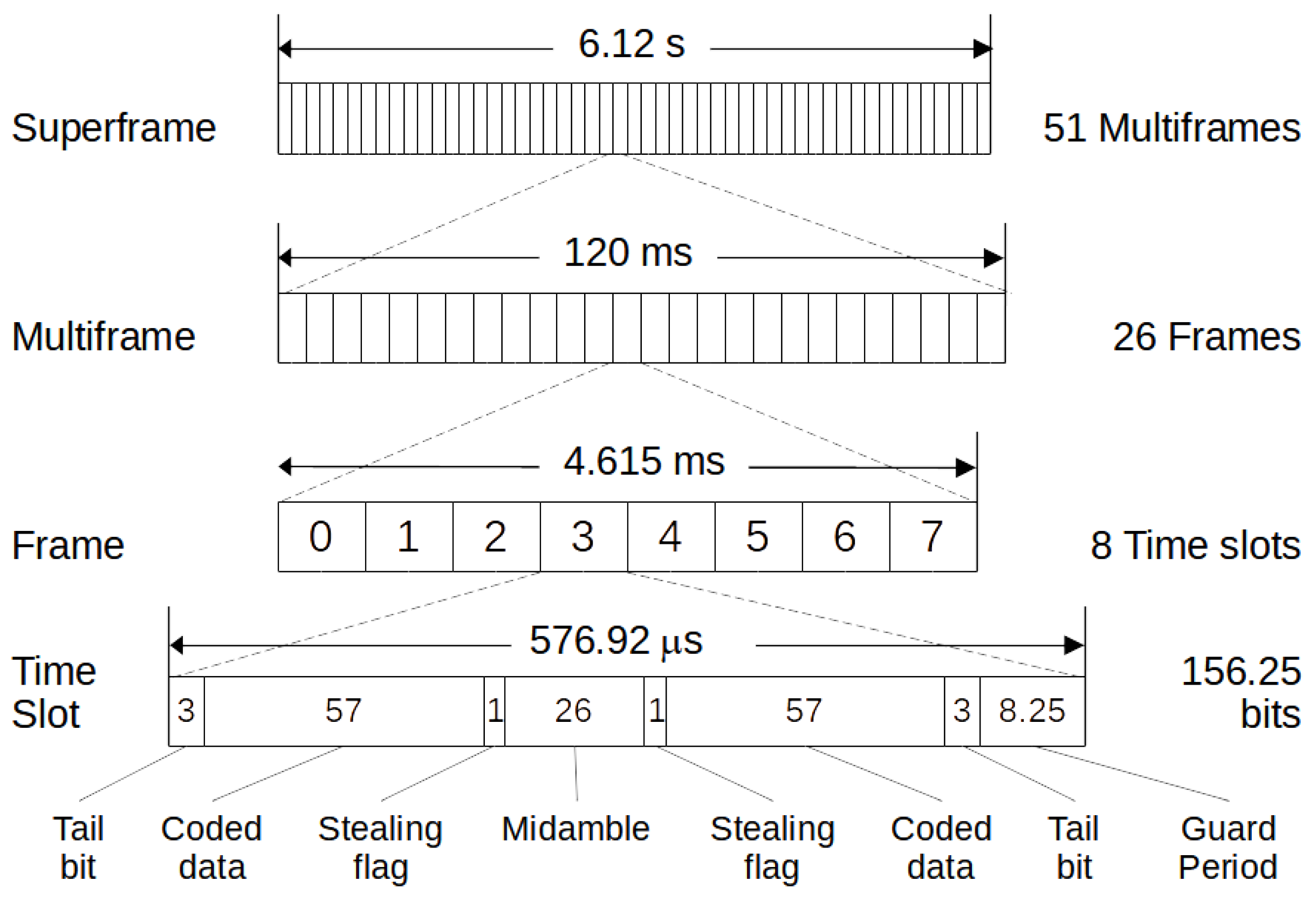


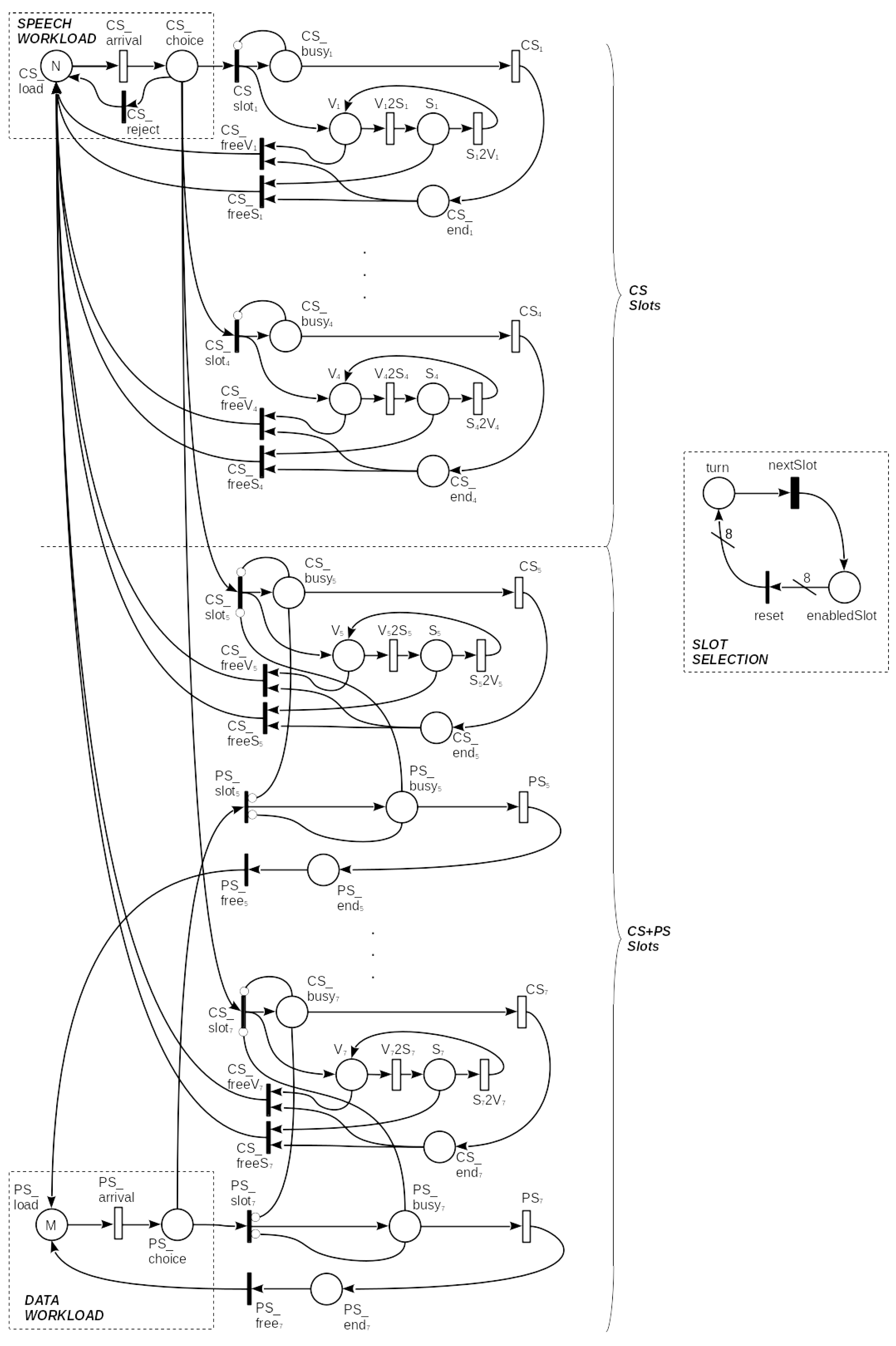
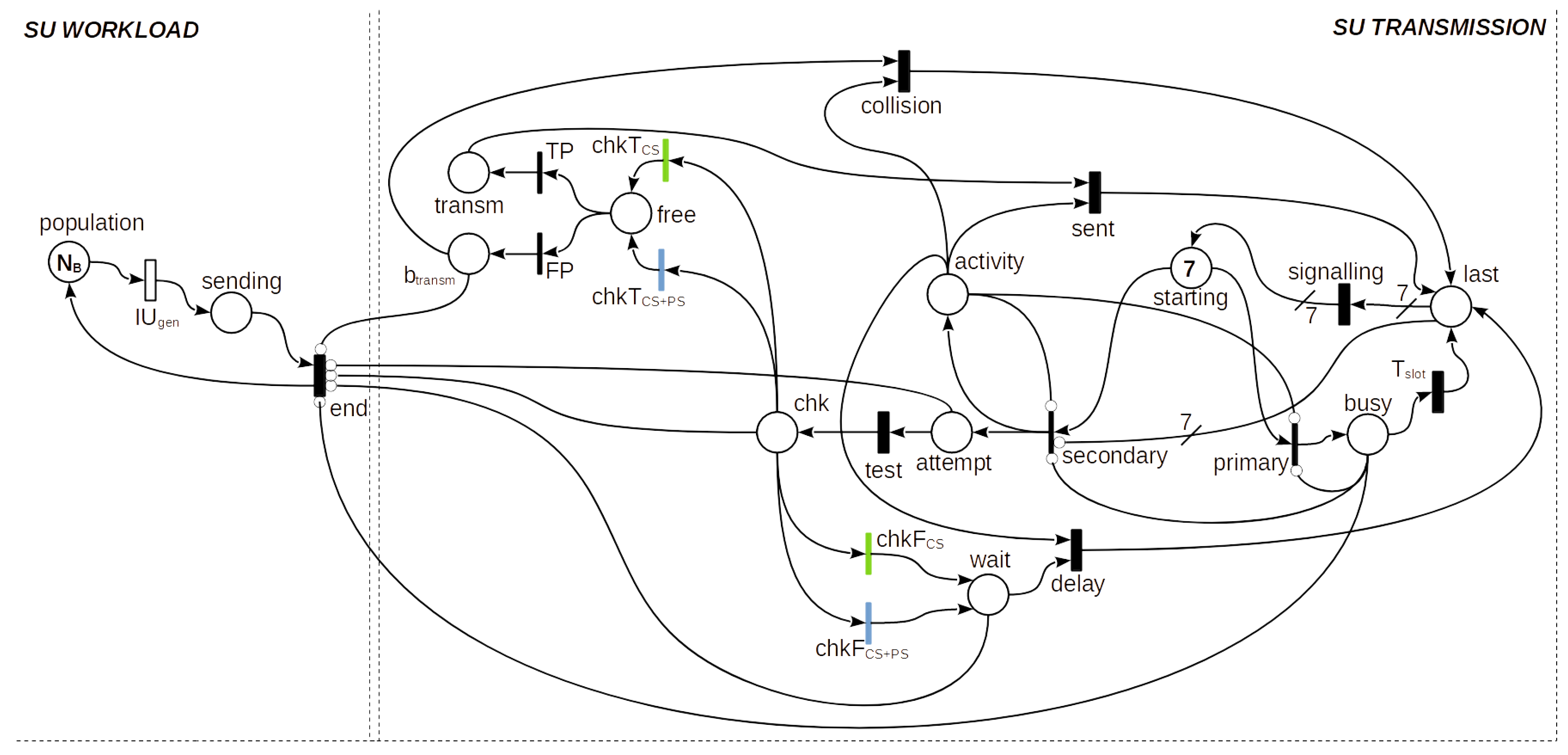
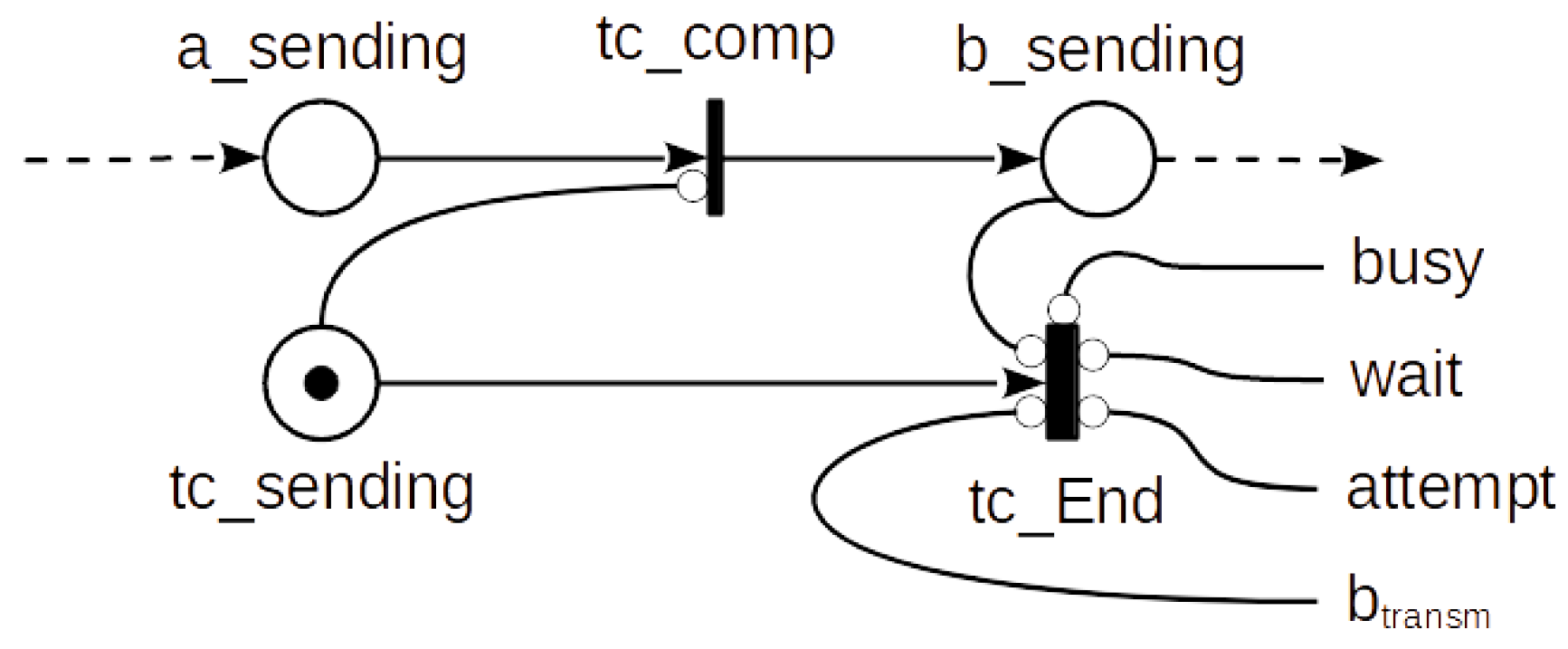
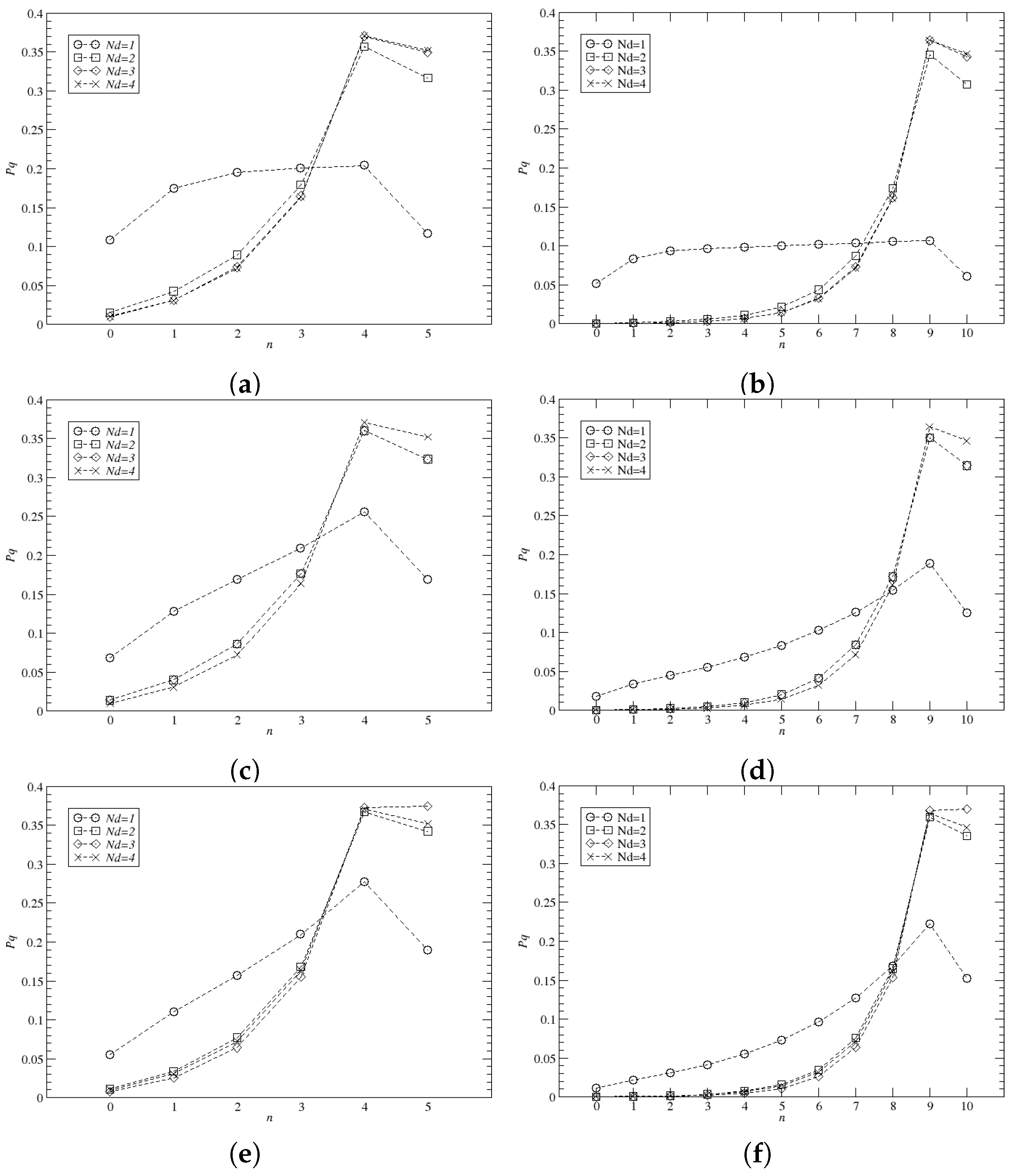

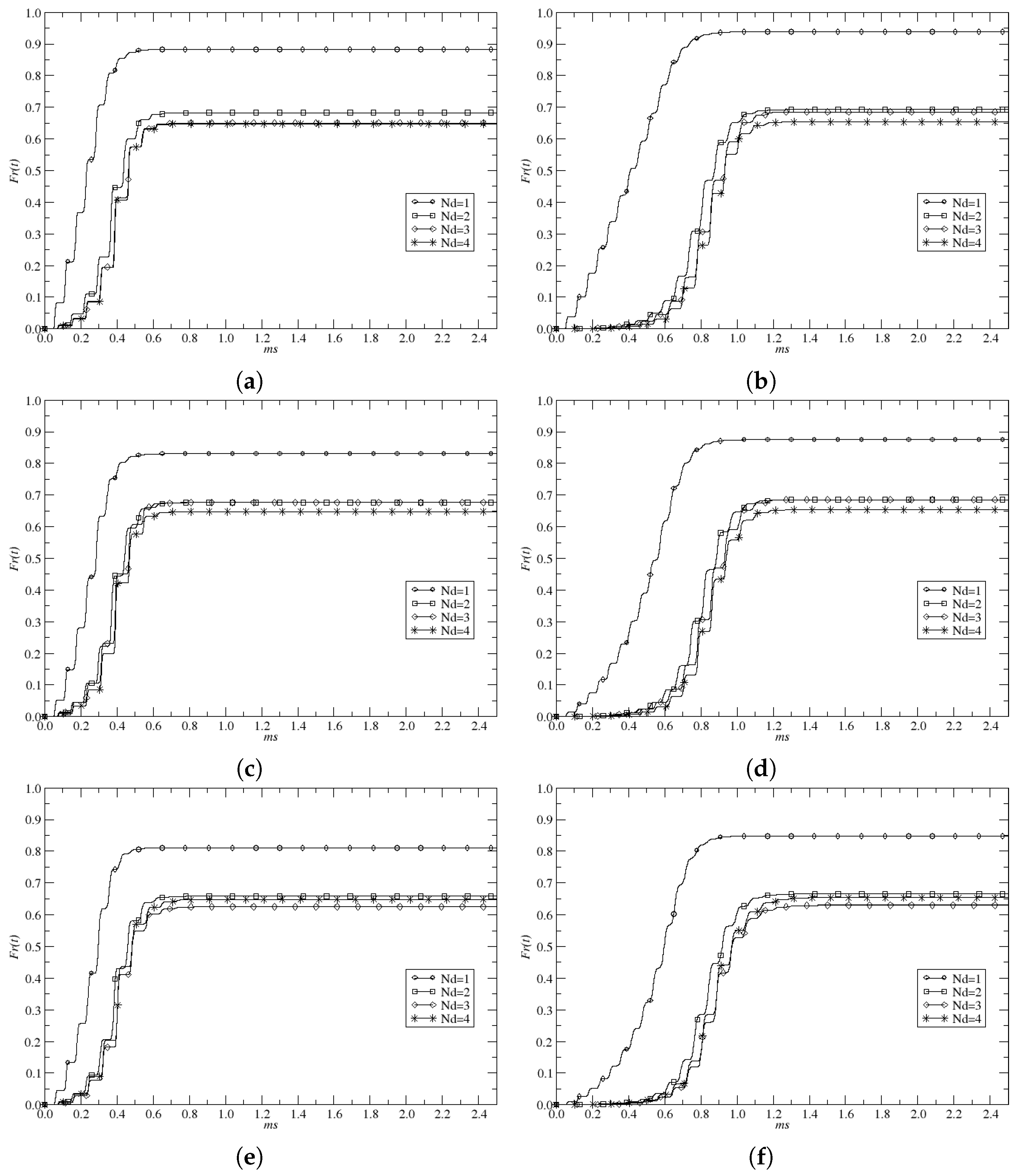
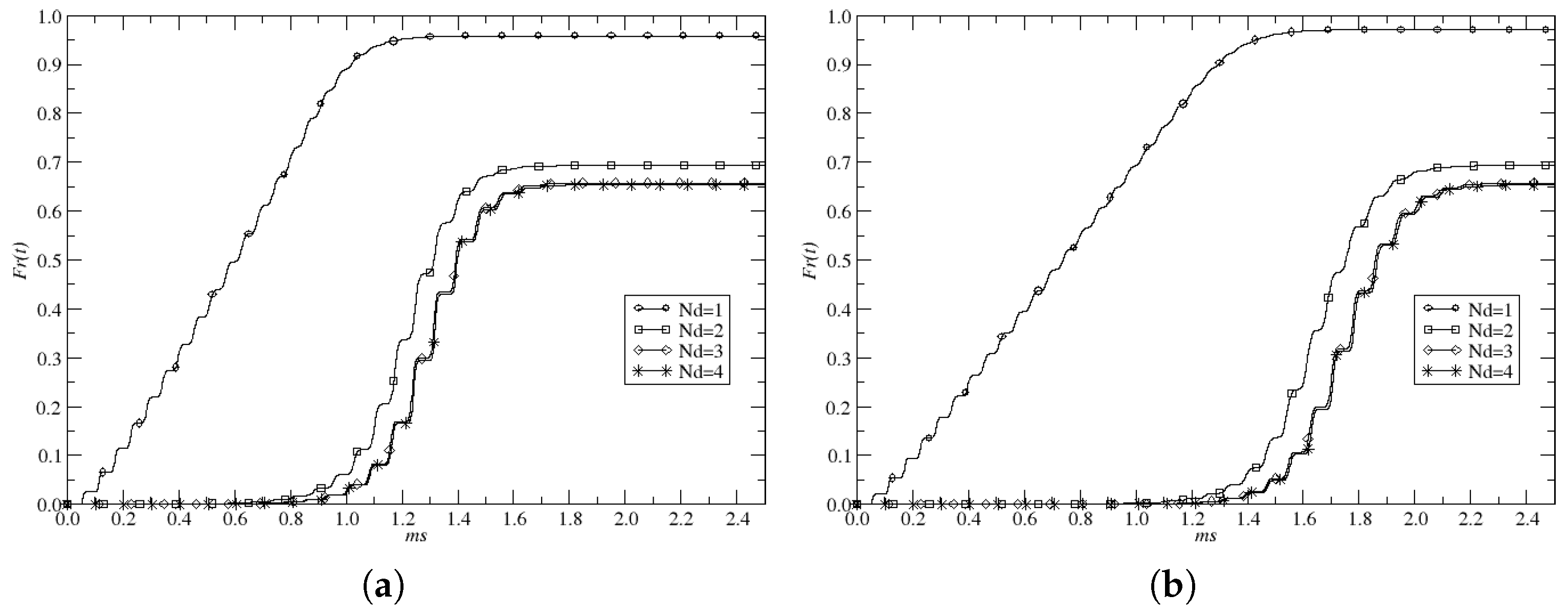
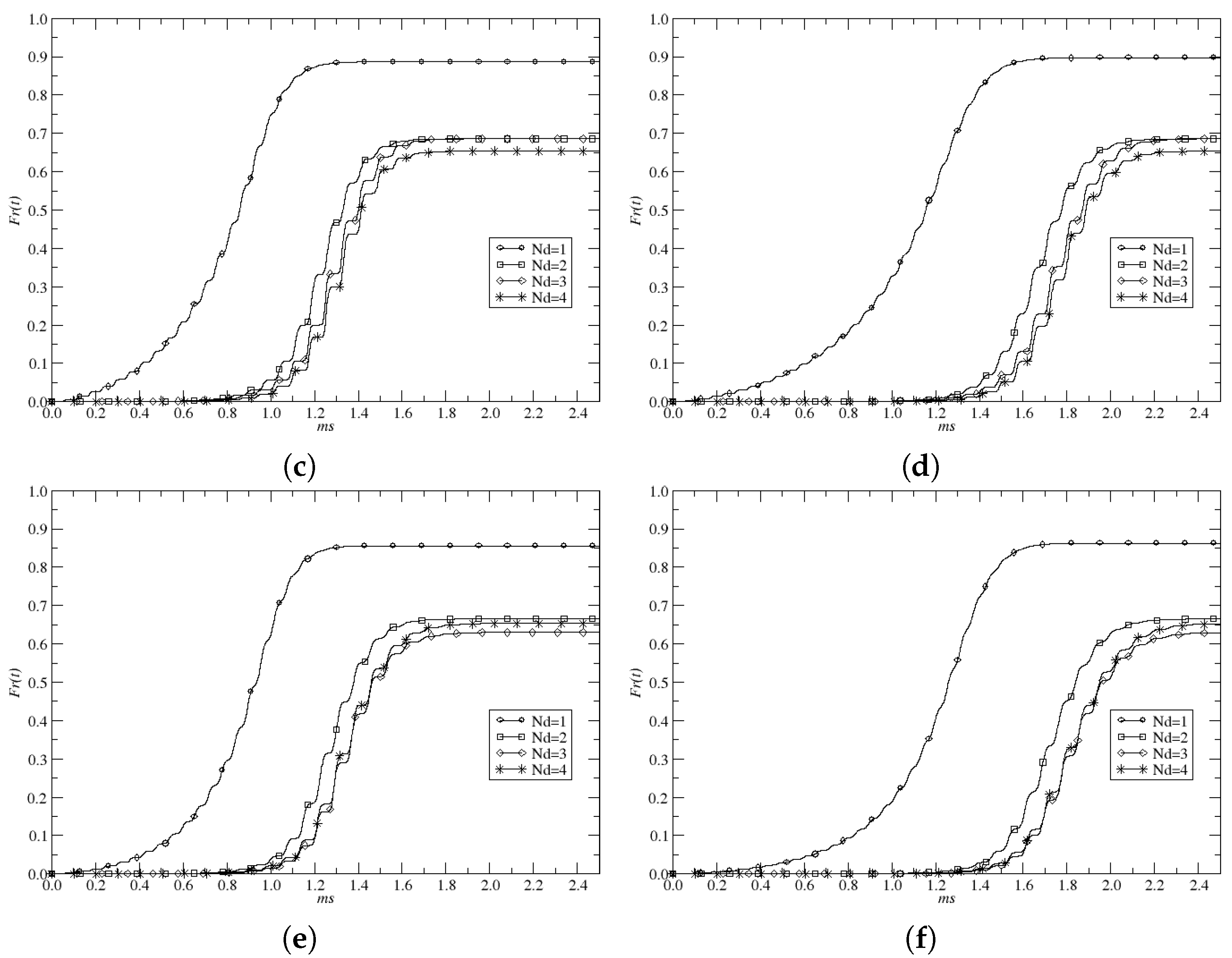
| Operating Band | Uplink Frequencies | Downlink Frequencies |
|---|---|---|
| GSM450 | 450.4–457.6 MHz | 460.4–467.6 MHz |
| GSM480 | 478.8–486.0 MHz | 488.8–496.0 MHz |
| GSM850 | 824.0–849.0 MHz | 869.0–894.0 MHz |
| GSM900 (primary) | 890.0–915.0 MHz | 935.0–960.0 MHz |
| GSM900 (extended) | 880.0–915.0 MHz | 925.0–960.0 MHz |
| GSM900 (railways) | 876.0–915.0 MHz | 921.0–960.0 MHz |
| DCS1800 | 1710.0–1785.0 MHz | 1805.0–1880.0 MHz |
| PCS1900 | 1850.0–1910.0 MHz | 1930.0–1990.0 MHz |
| Model | Transition | Enabling Function |
|---|---|---|
| PU model | CSsloti | |
| CSi | ||
| Vi2Si | ||
| Si2Vi | ||
| SU model | primary | |
| secondary | ||
| chkTCS | ||
| chkFCS | ||
| chkTCS+PS | ||
| chkFCS+PS |
| 1 | 2 | 3 | 4 | ||
|---|---|---|---|---|---|
| 0.3 | 0.993 | 0.993 | 0.993 | 0.993 | |
| 1.0 | 0.977 | 0.977 | 0.977 | 0.977 | |
| 3.0 | 0.933 | 0.933 | 0.933 | 0.933 | |
| 1 | 2 | 3 | 4 | ||
|---|---|---|---|---|---|
| 0.3 | 0.399 | 0.0627 | 0.00418 | 0.000268 | |
| 1.0 | 0.392 | 0.0618 | 0.00414 | 0.000267 | |
| 3.0 | 0.374 | 0.0596 | 0.00403 | 0.000263 | |
| QS = 5 | |||||
| 1 | 2 | 3 | 4 | ||
| 0.30 | 0.117 | 0.317 | 0.350 | 0.352 | |
| 1.00 | 0.170 | 0.324 | 0.324 | 0.352 | |
| 3.00 | 0.190 | 0.342 | 0.375 | 0.352 | |
| QS = 10 | |||||
| 1 | 2 | 3 | 4 | ||
| 0.30 | 0.061 | 0.307 | 0.343 | 0.346 | |
| 1.00 | 0.125 | 0.314 | 0.314 | 0.346 | |
| 3.00 | 0.152 | 0.335 | 0.370 | 0.346 | |
| QS = 15 | |||||
| 1 | 2 | 3 | 4 | ||
| 0.30 | 0.042 | 0.307 | 0.343 | 0.346 | |
| 1.00 | 0.113 | 0.314 | 0.314 | 0.346 | |
| 3.00 | 0.144 | 0.335 | 0.370 | 0.346 | |
| QS = 20 | |||||
| 1 | 2 | 3 | 4 | ||
| 0.30 | 0.029 | 0.307 | 0.343 | 0.346 | |
| 1.00 | 0.103 | 0.314 | 0.314 | 0.346 | |
| 3.00 | 0.137 | 0.335 | 0.370 | 0.346 | |
| QS = 5 | |||||
| 1 | 2 | 3 | 4 | ||
| 0.30 | 40,993 | 33,162 | 32,564 | 32,487 | |
| 1.00 | 40,070 | 33,105 | 31,801 | 32,389 | |
| 3.00 | 39,392 | 32,721 | 32,238 | 31,404 | |
| QS = 10 | |||||
| 1 | 2 | 3 | 4 | ||
| 0.30 | 21,716 | 15,204 | 14,968 | 14,977 | |
| 1.00 | 19,080 | 15,162 | 14,463 | 14,866 | |
| 3.00 | 18,150 | 15,030 | 14,877 | 14,418 | |
| QS = 15 | |||||
| 1 | 2 | 3 | 4 | ||
| 0.30 | 14,811 | 9773 | 9669 | 9680 | |
| 1.00 | 11,986 | 9754 | 9284 | 9597 | |
| 3.00 | 11,300 | 9696 | 9634 | 9308 | |
| QS = 20 | |||||
| 1 | 2 | 3 | 4 | ||
| 0.30 | 11,621 | 7198 | 7140 | 7150 | |
| 1.00 | 8715 | 7186 | 6833 | 7084 | |
| 3.00 | 8162 | 7155 | 7123 | 6871 | |
| QS = 5 | |||||
| 1 | 2 | 3 | 4 | ||
| 0.30 | 0.200 | 0.247 | 0.252 | 0.252 | |
| 1.00 | 0.204 | 0.247 | 0.258 | 0.253 | |
| 3.00 | 0.208 | 0.250 | 0.254 | 0.261 | |
| QS = 10 | |||||
| 1 | 2 | 3 | 4 | ||
| 0.30 | 0.377 | 0.539 | 0.547 | 0.547 | |
| 1.00 | 0.429 | 0.540 | 0.566 | 0.551 | |
| 3.00 | 0.451 | 0.545 | 0.551 | 0.568 | |
| QS = 15 | |||||
| 1 | 2 | 3 | 4 | ||
| 0.30 | 0.553 | 0.838 | 0.847 | 0.846 | |
| 1.00 | 0.683 | 0.840 | 0.882 | 0.854 | |
| 3.00 | 0.725 | 0.845 | 0.850 | 0.880 | |
| QS = 20 | |||||
| 1 | 2 | 3 | 4 | ||
| 0.30 | 0.705 | 1.138 | 1.147 | 1.146 | |
| 1.00 | 0.940 | 1.140 | 1.199 | 1.156 | |
| 3.00 | 1.004 | 1.145 | 1.150 | 1.192 | |
| QS = 5 | |||||
| 1 | 2 | 3 | 4 | ||
| 0.30 | 0.010 | 0.017 | 0.019 | 0.020 | |
| 1.00 | 0.010 | 0.017 | 0.019 | 0.020 | |
| 3.00 | 0.010 | 0.019 | 0.022 | 0.022 | |
| QS = 10 | |||||
| 1 | 2 | 3 | 4 | ||
| 0.30 | 0.037 | 0.055 | 0.067 | 0.068 | |
| 1.00 | 0.033 | 0.057 | 0.063 | 0.069 | |
| 3.00 | 0.032 | 0.065 | 0.080 | 0.075 | |
| QS = 15 | |||||
| 1 | 2 | 3 | 4 | ||
| 0.30 | 0.082 | 0.115 | 0.146 | 0.149 | |
| 1.00 | 0.063 | 0.121 | 0.133 | 0.151 | |
| 3.00 | 0.058 | 0.139 | 0.175 | 0.163 | |
| QS = 20 | |||||
| 1 | 2 | 3 | 4 | ||
| 0.30 | 0.145 | 0.199 | 0.256 | 0.261 | |
| 1.00 | 0.102 | 0.210 | 0.231 | 0.266 | |
| 3.00 | 0.089 | 0.243 | 0.310 | 0.286 | |
Disclaimer/Publisher’s Note: The statements, opinions and data contained in all publications are solely those of the individual author(s) and contributor(s) and not of MDPI and/or the editor(s). MDPI and/or the editor(s) disclaim responsibility for any injury to people or property resulting from any ideas, methods, instructions or products referred to in the content. |
© 2023 by the authors. Licensee MDPI, Basel, Switzerland. This article is an open access article distributed under the terms and conditions of the Creative Commons Attribution (CC BY) license (https://creativecommons.org/licenses/by/4.0/).
Share and Cite
Serrano, S.; Scarpa, M. A Petri Net Model for Cognitive Radio Internet of Things Networks Exploiting GSM Bands. Future Internet 2023, 15, 115. https://doi.org/10.3390/fi15030115
Serrano S, Scarpa M. A Petri Net Model for Cognitive Radio Internet of Things Networks Exploiting GSM Bands. Future Internet. 2023; 15(3):115. https://doi.org/10.3390/fi15030115
Chicago/Turabian StyleSerrano, Salvatore, and Marco Scarpa. 2023. "A Petri Net Model for Cognitive Radio Internet of Things Networks Exploiting GSM Bands" Future Internet 15, no. 3: 115. https://doi.org/10.3390/fi15030115
APA StyleSerrano, S., & Scarpa, M. (2023). A Petri Net Model for Cognitive Radio Internet of Things Networks Exploiting GSM Bands. Future Internet, 15(3), 115. https://doi.org/10.3390/fi15030115








